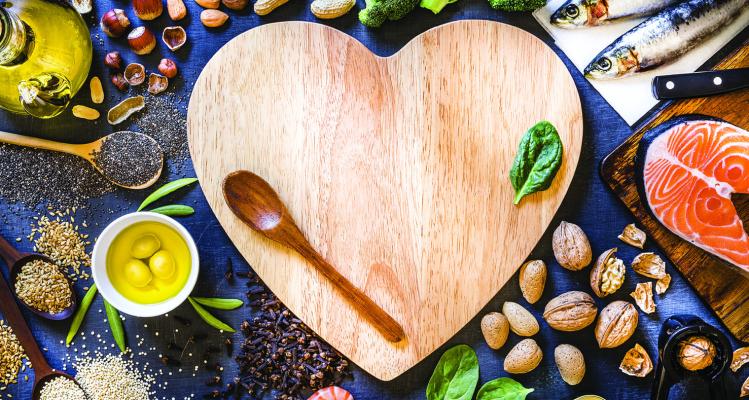Eating for Your Heart
If you’re looking for a hearthealthy diet, the American Heart Association has some recommendations.
An evidence-based analysis of 10 popular dietary patterns shows that some promote heart health better than do others. A new American Heart Association scientific statement concludes that the Mediterranean, Dietary Approach to Stop Hypertension (DASH), pescatarian and vegetarian eating patterns most strongly align with heart-healthy eating guidelines issued by the AHA in 2021, whereas the popular paleolithic (paleo) and ketogenic (keto) diets fall short. The statement was published online April 27 in the journal Circulation.
“The good news for the public and their clinicians is that there are several dietary patterns that allow for substantial flexibility for following a heart healthy diet -- DASH, Mediterranean, vegetarian,” writesgroupchairChristopher Gardner, Ph.D., with Stanford University in California, in a news release. “However, some of the popular diets -- particularly paleo and keto -- are so strictly restrictive of specific food groups that when these diets are followed as intended by their proponents, they are not aligned with the scientific evidence for a heart-healthy diet.”
If you’re confused about what to eat for heart health, you’re not alone. That’s what prompted the AHA to evaluate the various diets. The writing group rated on a scale of 1-100 how well 10 popular diets or eating patterns align with AHA dietary advice for heart-healthy eating.
Just what does hearthealthy eating mean? Consuming a wide variety of fruits and vegetables; choosing mostly whole grains instead of refined grains; using liquid plant oils rather than tropical oils; eating healthy sources of protein, such as from plants, seafood or lean meats; minimizing added sugars and salt; limiting alcohol; choosing minimally processed foods instead of ultra-processed foods; and following this guidance wherever food is prepared or consumed.
The 10 diets/dietary patterns the AHA group evaluated were DASH, Mediterranean- style, pescatarian, ovo-lacto vegetarian, vegan, low-fat, very low-fat, lowcarbohydrate, paleo and very low-carbohydrate/keto patterns.
Q and A Q: Does the nutrition of bell peppers vary by color?
A: No matter the color of your pepper, the protein, fat, carbohydrate and fiber content are nearly the same. Red, yellow and orange bell peppers are simply the ripe forms of different green peppers. However, there are some differences in vitamin, mineral and phytonutrient content, though small. For example, green peppers have 80 milligrams of vitamin C per 3 ounces, while yellow peppers contain 184 milligrams per 3 ounces. To put that in perspective, the RDA for vitamin C is 75-90 milligrams of vitamin C per day. Either color of pepper would be a good source of vitamin C. Peppers also differ in content of carotenoids, with red peppers being loaded with beta-carotene, a form of vitamin A, and yellow peppers having no beta-carotene. Orange peppers have about 10 times the amount of lutein and zeaxanthin, carotenoids important for eye health. Your best bet is to eat all the colors. The more colorful your diet, the healthier it is.
RECIPE
We’re all trying to eat more vegetables. Adding them to breakfast is a smart strategy to increase your intake and reach your daily goals. This recipe for Mexican-inspired egg and veggie skillet is from “Cooking ala Heart” by Linda Hachfeld and Amy Myrdal Miller, both registered dietitians.
MEXICAN-INSPIRED EGG AND VEGGIE SKILLET
Servings: 4 1 teaspoon cumin seeds 1 tablespoon extra-virgin olive oil 1 large white onion, diced 1 zucchini, diced 1 poblano chile, diced 1 jalapeno chile, diced 1 bunch cilantro, stems minced, leaves chopped for serving 1/2 teaspoon kosher salt One (15-ounce) can black beans, drained and rinsed One (14.5-ounce) can diced tomatoes with jalapenos 2 cups frozen white corn kernels 1/2 teaspoon ground chipotle chile powder 4 large eggs Heat a large saute pan or skillet over medium-high heat for 30 seconds, then add the cumin seeds. Dry-toast the cumin until it begins to perfume the air, 30 seconds. Reduce the heat to medium and add the oil, followed by the onion, zucchini, poblano, jalapeno, cilantro stems and salt. Saute until the vegetables have softened, the zucchini has released its moisture and the poblano has turned a dark glossy green, 10 to 12 minutes. Add the beans, tomatoes, corn and ground chipotle. Stir well, cover and cook until the vegetables are simmering gently, 8 to 10 minutes. Use a large spoon to create four “cups” (indentations) in the vegetables. Crack one egg into each cup, cover and cook until the egg whites are opaque, 5 to 6 minutes. The yolks may still be soft; cook longer if you like your egg yolks cooked to a firmer consistency. Divide the eggs and vegetables among four bowls, top with cilantro leaves and serve. Serves 4.
Per serving: 377 calories; 20 grams protein; 56 grams carbohydrates; 9 grams total fat (2 grams saturated); 14 grams fiber; 0 grams added sugars; 628 milligrams sodium.
Charlyn Fargo is a registered dietitian with SIU Med School in Springfield, Illinois. For comments or questions, contact her at charfarg@aol.com or follow her on Twitter @NutritionRD. To find out more about Charlyn Fargo and read features by other Creators writers and cartoonists, visit the Creators website at www.creators.com.

